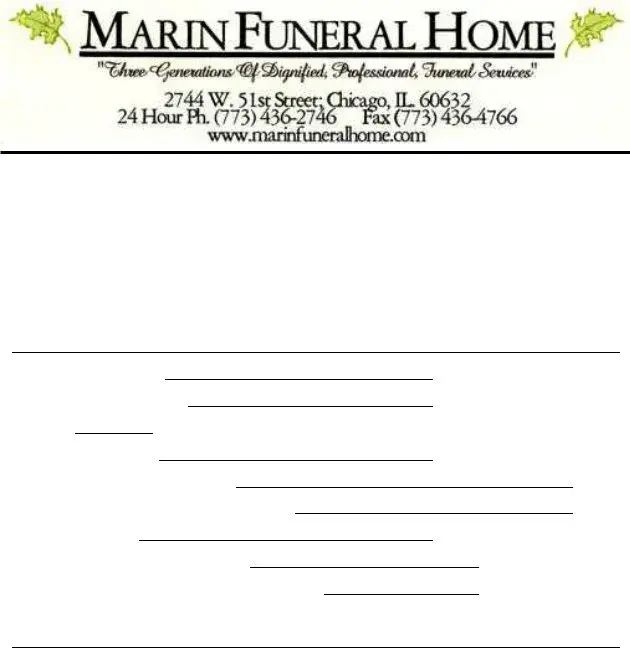ILLINOIS DEATH CERTIFICATE WORKSHEET
Please print or type
1)NAME OF DECEASED:
2)DATE OF DEATH:
3)COUNTY OF DEATH:
4)AGE:
5)DATE OF BIRTH:
6)CITY OR TOWN OF DEATH:
7)HOSPITAL OR INSTITUTION NAME:
8)BIRTHPLACE:
9)SOCIAL SECURITY NUMBER:
10)MARITAL STATUS AT TIME OF DEATH:
11)SURVIVING SPOUSE’S NAME (If wife, give full name prior to first marriage):
|
|
|
|
|
|
|
|
|
12) EVER IN U.S. ARMED FORCES?: □ YES □ NO |
|
|
|
13) HOME ADDRESS OF DECEASED: |
|
|
|
|
14) CITY: |
|
INSIDE CITY LIMITS?: |
□ YES □ NO |
|
15) COUNTY: |
|
16) STATE: |
|
17) ZIP CODE: |
|
|
18)FATHER’S NAME (First, middle, last):
19)MOTHER’S NAME PRIOR TO FIRST MARRIAGE (First, middle, last):
20)INFORMANT’S NAME:
21)RELATIONSHIP TO DECEDENT:
22)MAILING ADDRESS (Street & No.,City or Town, Zip Code):
23) METHOD OF DISPOSITION: □ Burial □ Cremation □ Donation □ Entombment 24)PLACE OF DISPOSITION (Name of cemetery, crematory, other):
25)LOCATION (City, Town & State):
26)DATE OF DISPOSITION:
27)DECEDENT’S EDUCATION LEVEL (Highest grade completed):
28)DECEDENT OF HISPANIC ORIGIN? (Check the one that best describes whether the
decedent is Spanish/Hispanic/Latino. Check “No” if decedent is not Spanish/Hispanic/Latino):
□No, not Spanish/Hispanic/Latino
□Yes, Mexican, Mexican American, Chicano
□Yes, Puerto Rican
□Yes, Cuban
□ Yes, Other Spanish/Hispanic/Latino |
Specify: |
29)DECEDENT’S RACE (Check one or more races to indicate what the decedent considered himself or herself to be):
|
|
|
|
|
|
|
|
|
|
|
□ White |
□ Black or African American |
□ American Indian |
□ Chinese |
□ Filipino |
□ Japanese |
□ Korean |
□ Vietnamese |
□ Other Asian (Specify): |
|
□ Native Hawaiian |
□ Guamanian or Chamorro |
□ Samoan |
|
|
|
|
□ Other Pacific Islander (Specify): |
|
|
□ Other (Specify): |
|
|
30)DECEDENT’S USUAL OCCUPATION
31)TYPE OF INDUSTRY
32)HOW MANY DEATH CERTIFICATES WILL YOU NEED?


